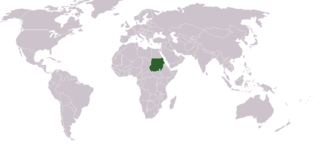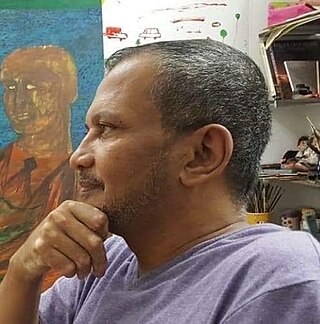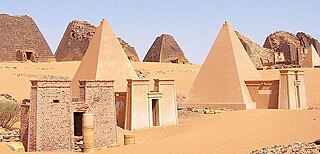Related Research Articles

The rich and varied music of Sudan has traditional, rural, northeastern African roots and also shows Arabic, Western or other African influences, especially on the popular urban music from the early 20th century onwards. Since the establishment of big cities like Khartoum as melting pots for people of diverse backgrounds, their cultural heritage and tastes have shaped numerous forms of modern popular music. In the globalized world of today, the creation and consumption of music through satellite TV or on the Internet is a driving force for cultural change in Sudan, popular with local audiences as well as with Sudanese living abroad.

The following outline is provided as an overview of and topical guide to Sudan:

Gadalla Gubara was a Sudanese cameraman, film producer, director and photographer. Over five decades, he produced more than 50 documentaries and three feature films. He was a pioneer of African cinema, having been a co-founder of both the Pan-African Federation of Filmmakers FEPACI and the FESPACO Film festival. His daughter, Sara Gubara, who is a graduate of Cairo Higher Institute of Cinema, Egypt, assisted him with his later film projects, after he had lost his eyesight. She is considered to be Sudan's first female film director.
Ibrahim El-Salahi is a Sudanese painter, former public servant and diplomat. He is one of the foremost visual artists of the Khartoum School, considered as part of African Modernism and the pan-Arabic Hurufiyya art movement, that combined traditional forms of Islamic calligraphy with contemporary artworks. On the occasion of the Tate Modern gallery's first retrospective exhibition of a contemporary artist from Africa in 2013, El-Salahi's work was characterized as "a new Sudanese visual vocabulary, which arose from his own pioneering integration of Islamic, African, Arab and Western artistic traditions."

Salah Elmur also spelled Salah El Mur is a contemporary Sudanese painter, graphic designer, author, and filmmaker, who lives and works in Khartoum.
Muhammed Muheisen is a two-time Pulitzer Prize winning photographer and the recipient of numerous international awards. He is a National Geographic photographer and the founder of the Dutch non-profit organization Everyday Refugees Foundation.

Photography in Sudan refers to both historical as well as to contemporary photographs taken in the cultural history of today's Republic of the Sudan. This includes the former territory of present-day South Sudan, as well as what was once Anglo-Egyptian Sudan, and some of the oldest photographs from the 1860s, taken during the Turkish-Egyptian rule (Turkiyya). As in other countries, the growing importance of photography for mass media like newspapers, as well as for amateur photographers has led to a wider photographic documentation and use of photographs in Sudan during the 20th century and beyond. In the 21st century, photography in Sudan has undergone important changes, mainly due to digital photography and distribution through social media and the Internet.
Cinema of Sudan refers to both the history and present of the making or screening of films in cinemas or film festivals, as well as to the persons involved in this form of audiovisual culture of the Sudan and its history from the late nineteenth century onwards. It began with cinematography during the British colonial presence in 1897 and developed along with advances in film technology during the twentieth century.

Ola Alsheikh, also known as Ola Abbas Alsheikh Omer, is a Sudanese freelance documentary photographer. She is mainly known for her pictures of everyday life and social events in Khartoum. In her work, she has placed a special focus on images of women and girls, as well as on the social and ethnic diversity in Sudan.
Omnia Shawkat is a Sudanese journalist, digital stories and cross-cultural curator. She is co-founder and manager of the cultural online platform Andariya, based in Sudan, South Sudan and Uganda, covering other countries in East Africa and the Horn of Africa as well.
Ala Kheir is a Sudanese photographer, cinematographer and mechanical engineer. He became known as one of the founders of the Sudanese Photographers Group in Khartoum in 2009 and through international exhibitions of his photographs, as well as for networking and training for photographers in Africa.
Rashid Mahdi was a Sudanese photographer, active in Atbara from the 1950s to the 1970s. French photographer Claude Iverné, founder of a large archive of photographs dedicated to this "Golden Age" of photography in Sudan, called Mahdi "certainly the most sophisticated and one of the major African photographers of the 20th century."

The visual arts of Sudan encompass the historical and contemporary production of objects made by the inhabitants of today's Republic of the Sudan and specific to their respective cultures. This encompasses objects from cultural traditions of the region in North-East Africa historically referred to as the Sudan, including the southern regions that became independent as South Sudan in 2011.

The architecture of Sudan mirrors the geographical, ethnic and cultural diversity of the country and its historical periods. The lifestyles and material culture expressed in human settlements, their architecture and economic activities have been shaped by different regional and environmental conditions. In its long documented history, Sudan has been a land of changing and diverse forms of human civilization with important influences from foreign cultures.
Hussein Shariffe was a Sudanese filmmaker, painter, poet and university lecturer at the University of Khartoum. After years of schooling in Khartoum and in Alexandria, Egypt, he studied modern history and fine arts in England, where he had his first exhibition in London's Gallery One in 1957. Back in Sudan in the 1970s, he worked both at the Ministry of Culture and at the Faculty of Arts at the University of Khartoum. In 1973 he began a second artistic career as filmmaker, producing several documentary films and cinematographic essays on subjects such as traditional rites or history in Sudan, as well as on life in exile during his later years in Cairo.

Soudan 2019, année zéro is a book about the Sudanese revolution, published in French in 2021. It contains descriptions, commentaries and photographs of the protestors' sit-in area during the weeks in May and June 2019 that led up to the Khartoum massacre. As additional visual documents, the book contains images by Sudanese documentary photographers, illustrating different stages and social backgrounds of the revolution up to the destruction of the sit-in by security forces on 3 June 2019.
Eythar Gubara, is a Sudanese freelance photographer and activist for human rights. She is mainly known for her documentary images of everyday life in Sudan and of events during the Sudanese Revolution. In her work, she has placed a special focus on images of women, as well as on social diversity in Sudan.

Salih Basheer is a Sudanese photographer.
Talal Afifi is a Sudanese film curator and producer. Further, he is the director of the Khartoum-based Sudan Film Factory as well as of the Sudan Independent Film Festival and has helped train a new generation of Sudanese filmmakers since 2009.

Mohamed Nureldin Abdallah is a Sudanese photojournalist. He has been working as resident photographer for Reuters since 2005, and has also worked for Agence France-Presse, Oxford Analytica and other news outlets. His photographs of Sudan, often focusing on the effects of war and social exclusion on ordinary people, have been featured in numerous international news reports.
References
- ↑ AFAC. "Mohamed Altoum". www.arabculturefund.org. Retrieved 13 May 2021.
- 1 2 Altoum, Mohamed; Estrin, James (18 March 2019). "A photographer's quest to discover his Nubian ancestry". The New York Times. ISSN 0362-4331 . Retrieved 13 May 2021.
- ↑ Diallo, Aïcha (29 October 2016). "Where the White Nile and the Blue Nile meet". Contemporary And. Retrieved 14 May 2021.
- ↑ Shawkat, Omnia (7 April 2013). "Mohamed Altoum: the photographer with the dashing smile". 500 Words Magazine. Retrieved 13 May 2021.
- ↑ "Mugran Foto Week 2016: "Modern Times" – Qantara.de". Qantara.de – Dialogue with the Islamic World. 2016. Retrieved 13 May 2021.
- ↑ See, for example, his participation in the Mugran Foto Workshops and Festivals in Khartoum, sourced in this article's Further reading section.
- ↑ "Presenting the AIR Award Winners... – Africa Centre". www.africacentre.net. 12 March 2018. Retrieved 13 May 2021.
- ↑ "Arab Documentary Photography Program grantees gather in Beirut". Magnum Foundation. 2018. Retrieved 13 May 2021.
- ↑ "CAP Prize – International Prize for Contemporary African Photography". CAP Prize. Retrieved 13 May 2021.
- 1 2 Garms, Juliette (12 November 2018). "Four to follow #11". Medium. Retrieved 13 May 2021.
- ↑ Sharjah Art Foundation. "Vantage Point Sharjah 2019". sharjahart.org. Retrieved 13 May 2021.